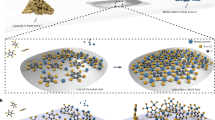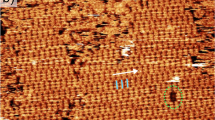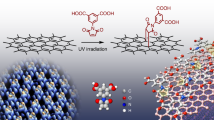Abstract
Self-assembled monolayers (SAMs) are widely used to engineer the surface properties of metals. The relatively simple and versatile chemistry of metal–thiolate bonds makes thiolate SAMs the preferred option in a range of applications, yet fragility and a tendency to oxidize in air limit their long-term use. Here, we report the formation of thiol-free self-assembled mono- and bilayers of glycol ethers, which bind to the surface of coinage metals through the spontaneous chemisorption of glycol ether-functionalized fullerenes. As-prepared assemblies are bilayers presenting fullerene cages at both the substrate and ambient interface. Subsequent exposure to functionalized glycol ethers displaces the topmost layer of glycol ether-functionalized fullerenes, and the resulting assemblies expose functional groups to the ambient interface. These layers exhibit the key properties of thiolate SAMs, yet they are stable to ambient conditions for several weeks, as shown by the performance of tunnelling junctions formed from SAMs of alkyl-functionalized glycol ethers. Glycol ether-functionalized spiropyrans incorporated into mixed monolayers lead to reversible, light-driven conductance switching. Self-assemblies of glycol ethers are drop-in replacements for thiolate SAMs that retain all of their useful properties while avoiding the drawbacks of metal–thiolate bonds.
This is a preview of subscription content, access via your institution
Access options
Access Nature and 54 other Nature Portfolio journals
Get Nature+, our best-value online-access subscription
$29.99 / 30 days
cancel any time
Subscribe to this journal
Receive 12 print issues and online access
$259.00 per year
only $21.58 per issue
Buy this article
- Purchase on Springer Link
- Instant access to full article PDF
Prices may be subject to local taxes which are calculated during checkout





Similar content being viewed by others
Data availability
The raw data used to prepare the STM, AFM, ellipsometry, water contact angle, EGaIn and XPS data in Figs. 1–5 and in the Supplementary Information are hosted at the University of Groningen according to the research data management plans described at https://www.rug.nl/research/zernike/rdmp. All raw and processed data are available for download from https://hdl.handle.net/10411/I3J7II.
Code availability
All of the raw data acquired using EGaIn and CP-AFM were processed using Scientific Python. The source code is publicly available at https://github.com/rchiechi/GaussFit and is retained internally in accordance with the aforementioned data retention policies.
References
Harder, P., Grunze, M., Dahint, R., Whitesides, G. M. & Laibinis, P. E. Molecular conformation in oligo(ethylene glycol)-terminated self-assembled monolayers on gold and silver surfaces determines their ability to resist protein adsorption. J. Phys. Chem. B 102, 426–436 (1998).
Paul, J., Meltzer, C., Braunschweig, B. & Peukert, W. Lubrication of individual microcontacts by a self-assembled alkyl phosphonic acid monolayer on α-Al2O3 (0001). Langmuir 32, 8298–8306 (2016).
Ramachandran, S. et al. Self-assembled monolayer mechanism for corrosion inhibition of iron by imidazolines. Langmuir 7463, 6419–6428 (1996).
Castañeda Ocampo, O. E. et al. Mechanism of orientation-dependent asymmetric charge transport in tunneling junctions comprising photosystem I. J. Am. Chem. Soc. 137, 8419–8427 (2015).
Bamdad, C. et al. A DNA self-assembled monolayer for the specific attachment of unmodified double- or single-stranded DNA. Biophys. J. 75, 1997–2003 (2003).
Ostuni, E., Yan, L. & Whitesides, G. M. The interaction of proteins and cells with self-assembled monolayers of alkanethiolates on gold and silver. Colloids Surf. B 15, 3–30 (1999).
Qiu, X. et al. Self-regenerating soft biophotovoltaic devices. ACS Appl. Mater. Interfaces 10, 37625–37633 (2018).
Sheves, M. & Cahen, D. Transistor configuration yields energy level control in protein-based junctions. Nanoscale 10, 21712–21720 (2018).
Kumar, S. et al. Chemical locking in molecular tunneling junctions enables nonvolatile memory with large on–off ratios. Adv. Mater. 1, 1807831 (2019).
Ai, Y. et al. In-place modulation of rectification in tunneling junctions comprising self-assembled monolayers. Nano Lett. 18, 7552–7559 (2018).
Vilan, A., Aswal, D. & Cahen, D. Large-area, ensemble molecular electronics: motivation and challenges. Chem. Rev. 117, 4248–4286 (2017).
Engelkes, V. B., Beebe, J. M. & Frisbie, C. D. Length-dependent transport in molecular junctions based on sams of alkanethiols and alkanedithiols: effect of metal work function and applied bias on tunneling efficiency and contact resistance. J. Am. Chem. Soc. 126, 14287–14296 (2004).
Simeone, F. C. et al. Defining the value of injection current and effective electrical contact area for EGaIn-based molecular tunneling junctions. J. Am. Chem. Soc. 135, 18131–18144 (2013).
Li, T. et al. Solution-processed ultrathin chemically derived graphene films as soft top contacts for solid-state molecular electronic junctions. Adv. Mater. 24, 1333–1339 (2012).
Wan, A. et al. Arrays of high quality sam-based junctions and their application in molecular diode based logic. Nanoscale 7, 19547–19556 (2015).
Kong, G. D. & Jae, H. Influence of air-oxidation on rectification in thiol-based molecular monolayers. J. Electrochem. Soc. 163, 115–121 (2016).
Schoenfisch, M. H. & Pemberton, J. E. et al. Air stability of alkanethiol self-assembled monolayers on silver and gold surfaces. J. Am. Chem. Soc. 7863, 4502–4513 (1998).
Hutt, D. A. & Leggett, G. J. Influence of adsorbate ordering on rates of UV photooxidation of self-assembled monolayers. J. Phys. Chem. 100, 6657–6662 (1996).
Aliara, D. L., Hill, M., Nuzzo, R. G., Laboratories, T. B. & Hill, M. Spontaneously organized molecular assemblies . 1. Formation, dynamics and physical properties of n-alkanoic acids adsorbed from solution on an oxidized aluminum surface. Langmuir 1, 45–52 (1985).
Liao, K. C., Yoon, H. J., Bowers, C. M., Simeone, F. C. & Whitesides, G. M. Replacing AgTSSCH2-R With AgTSO2C-R in EGaIn-based tunneling junctions does not significantly change rates of charge transport. Angew. Chem. 53, 3889–3893 (2014).
Bigelow, W. C., Pickett, D. L. & isman, W. A. Oleophobic monolayers. I. Films adsorbed from solution in non-polar liquids. J. Colloid Sci. 1, 513–538 (1946).
Llave, E. D., Clarenc, R., Schi, D. J. & Williams, F. J. Organization of alkane amines on a gold surface: structure, surface dipole and electron transfer. J. Phys. Chem. C 118, 468–475 (2014).
Hickman, J. J. et al. Combining spontaneous molecular assembly with microfabrication to pattern surfaces: selective binding of isonitriles to platinum microwires and characterization by electrochemistry and surface spectroscopy. J. Am. Chem. Soc. 111, 7271–7272 (1989).
Beebe, J. M., Engelkes, V. B., Miller, L. L. & Frisbie, C. D. Contact resistance in metal–molecule–metal junctions based on aliphatic SAMs: effects of surface linker and metal work function. J. Am. Chem. Soc. 124, 11268–11269 (2002).
Stapleton, J. J. et al. Self-assembly, characterization and chemical stability of isocyanide-bound molecular wire monolayers on gold and palladium surfaces. Langmuir 21, 11061–11070 (2005).
Zaba, T. et al. Formation of highly ordered self-assembled monolayers of alkynes on Au(111) substrate. J. Am. Chem. Soc. 136, 11918–11921 (2014).
Fracasso, D., Kumar, S., Rudolf, P. & Chiechi, R. C. Self-assembled monolayers of terminal acetylenes as replacements for thiols in bottom-up tunneling junctions. RSC Adv. 4, 56026–56030 (2014).
Song, P. et al. Noncovalent self-assembled monolayers on graphene as a highly stable platform for molecular tunnel junctions. Adv. Mater. 28, 631–639 (2016).
Song, P. et al. Stable molecular diodes based on π–π interactions of the molecular frontier orbitals with graphene electrodes. Adv. Mater. 30, 1706322 (2018).
Crudden, C. M. et al. Ultra stable self-assembled monolayers of n-heterocyclic carbenes on gold. Nat. Chem. 6, 409–414 (2014).
Wang, G. et al. Ballbot-type motion of N-heterocyclic carbenes on gold surfaces. Nat. Chem. 9, 152–156 (2016).
Puebla-hellmann, G., Venkatesan, K., Mayor, M. & Lörtscher, E. Metallic nanoparticle contacts for high-yield, ambient-stable molecular-monolayer devices. Nature 559, 232–235 (2018).
Akkerman, H. B., Blom, P. W. M., Leeuw, D. M. D. & Boer, B. D. Towards molecular electronics with large-area molecular junctions. Nature 441, 69–72 (2006).
Karuppannan, S. K., Hongting, H., Troadec, C., Vilan, A. & Nijhuis, C. A. Ultrasmooth and photoresist-free micropore-based EGaIn molecular junctions: fabrication and how roughness determines voltage response. Adv. Funct. Mater. 29, 1904452 (2019).
Shi, X.-Q., Van Hove, M. A. & Zhang, R.-Q. Survey of structural and electronic properties of C60 on close-packed metal surfaces. J. Mater. Sci. 47, 7341–7355 (2012).
Sogo, M. et al. C60 adsorbed on platinum surface: a good mediator of metal wave function. J. Phys. Chem. C 114, 3504–3506 (2010).
Pedio, M. et al. C60/metal surfaces: adsorption and decomposition. Surf. Sci. 437, 249–260 (1999).
Modesti, S., Cerasari, S. & Rudolf, P. Determination of charge states of C60 adsorbed on metal surfaces. Phys. Rev. Lett. 71, 2469–2472 (1993).
Zhang, Y. et al. Mechanically and electrically robust self-assembled monolayers for large-area tunneling junctions. J. Phys. Chem. C 121, 14920–14928 (2017).
Veenstra, S., Heeres, A., Hadziioannou, G., Sawatzky, G. & Jonkman, H. On interface dipole layers between C60 and Ag or Au. Appl. Phys. A 75, 661–666 (2002).
Akimov, A. V., Williams, C. & Kolomeisky, A. B. Charge transfer and chemisorption of fullerene molecules on metal surfaces: application to dynamics of nanocars. J. Phys. Chem. C 116, 13816–13826 (2012).
Xue, Y., Li, X., Li, H. & Zhang, W. Quantifying thiol–gold interactions towards the efficient strength control. Nat. Commun. 5, 4348 (2014).
Khassanov, A., Steinrück, H.-G., Schmaltz, T., Magerl, A. & Halik, M. Structural investigations of self-assembled monolayers for organic electronics: results from X-ray reflectivity. Acc. Chem. Res. 48, 1901–1908 (2015).
Sloan, J. et al. The size distribution, imaging and obstructing properties of C60 and higher fullerenes formed within arc-grown single walled carbon nanotubes. Chem. Phys. Lett. 316, 191–198 (2000).
Chiechi, R. C., Weiss, E. A., Dickey, M. D. & Whitesides, G. M. Eutectic gallium–indium (EGaIn): a moldable liquid metal for electrical characterization of self-assembled monolayers. Angew. Chem. 47, 142–144 (2008).
Qiu, L. et al. Rectification of current responds to incorporation of fullerenes into mixed-monolayers of alkanethiolates in tunneling junctions. Chem. Sci. 8, 2365–2372 (2017).
Baghbanzadeh, M. et al. Anomalously rapid tunneling: charge transport across self-assembled monolayers of oligo(ethylene glycol). J. Am. Chem. Soc. 139, 7624–7631 (2017).
Xie, Z., Ba, I., Oram, S., Smith, C. E. & Frisbie, D. Effect of heteroatom substitution on transport in alkanedithiol-based molecular tunnel junctions: evidence for universal behavior. ACS Nano 11, 569–578 (2017).
Kumar, S., Herpt, J. T. V. & Chiechi, R. C. Mixed monolayers of spiropyrans maximize tunneling conductance switching by photoisomerization at the molecule–electrode interface in EGaIn junctions. J. Am. Chem. Soc. 138, 12519–12526 (2016).
Kumar, S. et al. Eliminating fatigue in surface-bound spiropyrans. J. Phys. Chem. C 123, 25908–25914 (2019).
Horcas, I. et al. WSXM: a software for scanning probe microscopy and a tool for nanotechnology. Rev. Sci. Instrum. 78, 013705 (2007).
Kondo, T., Yanagida, M., Shimazu, K. & Uosaki, K. Determination of thickness of a self-assembled monolayer of dodecanethiol on Au(111) by angle-resolved X-ray photoelectron spectroscopy. Langmuir 14, 5656–5658 (1998).
Acknowledgements
R.C.C. and X.Q. acknowledge financial support from the Zernike Institute of Advanced Materials. R.C.C., V.I., S.R. and J.C.H. acknowledge support from the FOM Focus Group Next-Gen PV.
Author information
Authors and Affiliations
Contributions
X.Q. and R.C.C. conceived the idea. X.Q. designed the experiments, synthesized the alkylGEs, prepared all samples and junctions, performed the characterizations using EGaIn, AFM, XPS, ellipsometry and water contact angle, and analysed the data. V.I. synthesized SP-GE. L.Q. and J.C.H. synthesized PTEG-1. M.E. and M.S. performed STM measurements and analysed the data. S.R. synthesized the alkylC60s. J.D. and G.P. performed grazing-incidence wide-angle X-ray scattering and X-ray reflectivity measurements and analysed the data. X.Q. wrote the paper with R.C.C. All of the authors edited the manuscript before submission.
Corresponding author
Ethics declarations
Competing interests
The authors declare no competing interests.
Additional information
Publisher’s note Springer Nature remains neutral with regard to jurisdictional claims in published maps and institutional affiliations.
Supplementary information
Supplementary Information
Supplementary Figs. 1–34, Supplementary discussions in sections 3, 4.3, 5.1, 5.3, 5.5, 6, 8, 9 and 10 and Tables 1–11.
Source data
Source Data Fig. 1
Statistical source data of Fig. 1e,f.
Source Data Fig. 3
Statistical source data of Fig. 3.
Source Data Fig. 4
Statistical source data of Fig. 4.
Source Data Fig. 5
Statistical source data of Fig. 5.
Rights and permissions
About this article
Cite this article
Qiu, X., Ivasyshyn, V., Qiu, L. et al. Thiol-free self-assembled oligoethylene glycols enable robust air-stable molecular electronics. Nat. Mater. 19, 330–337 (2020). https://doi.org/10.1038/s41563-019-0587-x
Received:
Accepted:
Published:
Issue Date:
DOI: https://doi.org/10.1038/s41563-019-0587-x
This article is cited by
-
Non-covalent interaction-based molecular electronics with graphene electrodes
Nano Research (2023)
-
Hybrid molecular graphene transistor as an operando and optoelectronic platform
Nature Communications (2023)
-
Printable logic circuits comprising self-assembled protein complexes
Nature Communications (2022)
-
Two layers are better than one
Nature Materials (2020)



